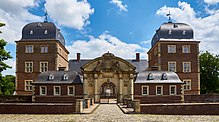Ahaus Castle
Ahaus Castle is a former residential palace of the Prince-Bishops of Münster in Ahaus in western Münsterland . The moated castle is located directly in the city center, adjacent is the new pedestrian zone of Ahaus with the market square and the tourist information.
history
The castle, built at the beginning of the 11th century, fell from the noblemen of Ahaus in 1406 to the Prince-Bishop of Münster , Otto IV. Von Hoya . On October 4, 1650, Prince-Bishop of Münster Christoph Bernhard von Galen visited Ahaus. At his instigation, the first German faience manufacture was founded in Ahaus in 1653 , but closed again in 1657. In 1688, the old castle was demolished on the instructions of Prince-Bishop Friedrich Christian von Plettenberg . The new building in the form of a baroque moated castle was carried out according to the plans of Ambrosius von Oelde and was completed in 1690. The entire complex, including the palace gardens , was not completed until 1718. When the work was completed, the new building had cost around 100,000 thalers. After being destroyed in the Seven Years' War added Johann Conrad Schlaun 1765-1767 in the garden front a central buttress with a large, double-barreled staircase . The castle served the prince-bishops of Münster as a summer residence. The Prince-Bishops Johann IV von Osnabrück , Christoph Bernhard von Galen and Franz Arnold von Wolff-Metternich zur Gracht died in Ahaus Castle .
The palace passed to the princes Salm-Salm and Salm-Kyrburg through the Reichsdeputationshauptschluss 1803 . As regent in the Principality of Salm , Prince Moritz zu Salm-Kyrburg resided there , later temporarily Friedrich IV zu Salm-Kyrburg , his nephew. In 1819 Hermann Oldenkott built a tobacco factory in the north wing of the palace. In 1829 the company acquired the baroque palace from Prince Salm-Kyrburg . It served as a production facility until 1929 and as a residence for the Oldenkott family until it was completely destroyed by a bomb attack in March 1945.
After the war, the Ahaus district acquired the ruins at the instigation of District Administrator Felix Sümmermann and began with the reconstruction, which was largely completed in 1952, so that the Ahaus district vocational school could move into the castle. Eugen Senge-Platten received the order to furnish the building with works of art. The castle park became the property of the city of Ahaus. Today the castle is the seat of the Technical Academy Ahaus and also houses the gatehouse and school museum.
Brief description
Ahaus Castle is an axially symmetrical complex made up of two groups of buildings originally on separate islands. The accessible by a gate tower Vorburg closes tightly against the urban development. Your inner courtyard opens over a bridge to the main island, which is completely surrounded by a graft . The entrance is marked by a triumphal gate between two guard houses . The cour d'honneur of the horseshoe-shaped, two-story three-wing building is flanked by mighty three-story pavilion towers. The main front of the middle tract is by a wide buttress with bauplastischem jewelry from Baumberger sand-lime divided rich, in the Attica area enhanced by a high Balusterreihe and a niche gable with Paul figure . The characteristics of the French and Dutch baroque are unmistakable here, but the architectural jewelry still appears to be bound by the principles of mannerism .
In 1766, Schlaun added a central projectile to the garden facade and an outside staircase leading down to the graft (so-called embarcadère, landing stage). Today a small footbridge leads from there to the castle garden. Corner pavilions emphasize the corners of the main platform in a similar way to Nordkirchen Castle . Nothing has been preserved from the interior of the castle.
To go biking
Ahaus Castle is the location of the 100 Castles Route through the Münsterland . Ahaus Castle is also integrated into the Münsterland honeycomb cycle path system via honeycomb 52. The so-called Fietsenbus, a bus with a bicycle trailer, runs through Ahaus from May to October, which enables bicycles to be taken along in the Borken district .
literature
- Eva-Maria Höper: The residential palace at Ahaus (= Westfälische Kunststätten . Issue No. 61)
- Westfälischer Heimatbund , Münster 1991, ISSN 0930-3952 .
- Volker Tschuschke: Castle and rule Ahaus . In: Werner Freitag (Ed.): Castles in Westphalia. Defense systems, mansions, economic centers (12th-14th centuries) . Aschendorff, Münster 2012, ISBN 978-3-402-15052-8 , pp. 213–242.
Web links
- Information about the castle on the website of the city of Ahaus
- Entry by Stefan Eismann on Schloss Ahaus in the scientific database " EBIDAT " of the European Castle Institute
- Landschaftsverband Westfalen-Lippe: Schlosspark Ahaus in LWL geodata culture
- Information about the castle and its park at gaerten-in-westfalen.de
- Short video about the castle
Individual evidence
- ↑ Schloss Ahaus on www.westfalen-adelssitze.de ( Memento from April 27, 2016 in the Internet Archive )
- ↑ a b Gerd Dethlefs (Ed.): Nordkirchen Castle . Deutscher Kunstverlag , Munich / Berlin 2012, ISBN 978-3-422-02304-8 , p. 32.
Coordinates: 52 ° 4 ′ 30.5 ″ N , 7 ° 0 ′ 33.5 ″ E


